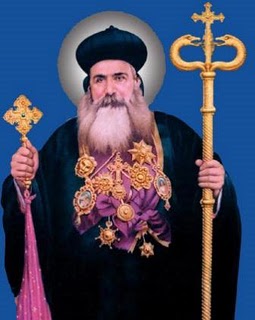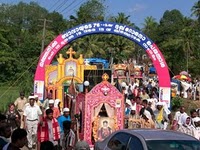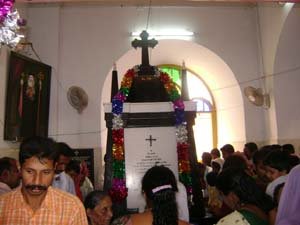|
|
By George Aramath
Itís been over a month since I last wrote. For some reason it seems like we skipped a month; I canít figure out how 29 days went by so fast!
I previously wrote about how the state of Kerala is appropriately called ďGodís Own CountryĒ because of its remarkable natural beauty. My reflections then turned negative when discussing about Kerala politics. Though this state is filled with political inefficiencies, it nonetheless holds a promising future filled with unprecedented economic growth. The tell-all reason for this is a recent episode with a Dubai-based company that started dialogue with Keralaís government to build a techno-park city. Politicians of course put roadblocks with constant protests. In any other case, the company would have left immediately. But because of their persistence, both sides eventually came to terms on a project called Smart City, projected to provide 90,000 jobs and costing over $350 million, which is a lot of money in Kerala. Plus, the Kerala Government has worked out a plan to develop IT parks in all districts. Within the next four to five years, the state is set to provide nearly one million new IT jobs.
So why Kerala? From a business perspective, this state is a gold mine. According to a report I read in a major Indian newspaper, salaries are 1/5th of the international average while the state offers the best of professional talent. Is there a better combination that this: more talent for less expense? Furthermore, operational costs are less than 50% when compared to other major IT parks; rent is lower by more than 60%. It makes too much sense to invest in Kerala. The job market will increase tremendously making Kerala, ďJobís Own CountryĒ.
I, for one, am not too happy with these changes due to, I admit, selfish reasons. I like present-day Kerala with its natural beauty and old-style of living. But even Kerala today is far different from five years ago. Itís becoming modernized and Americanized. Iím not against this; itís only that America already offers this to me. I like my Kerala to be the so-called ďunderdevelopedĒ state with its villages, fresh air, and open environment. I know it's selfish because if I were to tell a young Keralite that they should go back to villages and farm, theyíll probably teach me a couple of new unpleasant words! Opportunities . . . new jobs . . . income growth . . . economic prosperity . . . all this they say will make Keralites happier.
When I first told some people that Iím going to Kerala for 7 months, their response was that Iím going in order to get married. I protested. Now after 5 months my focus has turned a bit towards it. The traditional way to marry in Kerala is through arranged marriage. It's a far different concept from the American way. Arranged marriage has many meanings according to whom you ask. The typical thought that comes to mind is: parents arrange and son/daughter marries. The first are active, the second passive. So this option is viewed negatively because son/daughter marries whom their parents decide. This may have been true in the past, but times have changed.
In a love marriage, both sides find each other on their own. Itís romanticized everywhere: on TV, books, movies. But in many cases the guy and girl actually come to know of each other through someone else. There are rare exceptions but typically the first point of contact comes from an outsides source, be it friends, colleagues, website, etc. For instance, dating websites are nowadays becoming popular: match.com, eharmony.com. These sites are set up to match one person with another based upon certain criterions. An electronic program basically does the matching. So what Iím saying is that many marriages are "arranged", one way or another. And in the case of arranged marriages, that source is typically the parents. ďParents? What! Theyíll be the last ones I askĒ, some will say. But should this be so? If thereís open communication between parents and child similar to what exists between close friends, is there then anyone else that knows me better than my parents?
In addition, more people are involved in the entire process of an arranged marriage. The Keralite way of thinking is that families come together in a marriage, not just two individuals. So the families explore each other before proceeding. And then if the son likes the daughter and vice versa, marriage is set by both families. This does go against the ďme, myself, and IĒ mentality. But it must be mentioned here that even love marriages take place in similar ways. If the son/daughter has an open relationship with their parents, families are bound to be involved.
In my case, my parents told me a few weeks back about a girl who lives outside Kerala working as an English Literature lecturer. Once I saw a picture and approved, I was to meet her at her house, as itís typically done. Thereís wisdom behind this. The guy gets to see where she grew up, her parents, and how well she cooks! :) I joke about the last part because itís usually the local baker who prepares the light food.
Now imagine this: I enter the house with some of my family members, we chat with her parents for 15-20 minutes, and I still havenít seen the girl! Finally one of my uncles asks about her. Thank you! She enters and I catch a glimpse. Of course I canít focus on her too much or itíll be taken the wrong way! :) Then they gave us time alone to talk. Itís a ďspeed-datingĒ kind of experience.
On the way back home, my family gave me their opinions of the girl. Then they asked me; I told them that I had to talk with her again. So we met again. As it turned out, we felt that we were not a good match. Whereupon my family said itís entirely my choice since Iíll be the one living with her. Amen.
Though things did not work out, the experience was definitely worthwhile. If we wanted to continue talking, it was possible, but itís typically not extended for too long. I came to realize from all this that communication is key in the entire process. I must first be open with my family and then the girl. Once we hear their thoughts, the decision then is entirely up to me. Approached in this way, arranged marriages can be a useful option in finding our lifelong partner.
The last but most important point is Godís role in all this. No matter how much one talks or spends time with another in an arranged or love marriage, one cannot really know the other person until after marriage. It is here that we can give God His place as the unseen guide and silent adviser. With faith and trust, one finds their lifelong partner when itís ultimately left in His hands.
If not marriage, then whatís my main reason in coming to Kerala? To get spiritually exercised in my Syriac Orthodox faith. Two years of classroom theology had to be mixed with at least a few months of outside-the-classroom exercises. I wrote previously that Christians are today becoming over-fed and under-exercised. But a classic example against this is the pilgrimage to Manjinikara. This experience is literally and figuratively a spiritual exercise.
When I first saw this picture of one of our churchís Patriarchs (leader), I frankly thought, ďwhoís this big guy with all these metalsĒ. After coming to Kerala, this is no longer just a picture.
Born on October 30, 1867 in the city of Mardin, in present-day Turkey, this boy was seen one day wearing the robe of his father, acting like a priest. His father hid and heard his boyís talent and sincerity in singing church songs and thus blessed him. This interest led the boy to the local monastery . . . eventually he became the 119th Patriarch of the Syriac Orthodox Church, in 1917.
It was during this time that Christians faced many atrocities from the Muslim Turks. Patriarch Elias took the bold step of personally visiting the Sultan (leader) of Turkey in order to argue for the life and properties of Christians. He convinced the Sultan that Christians in Turkey were not his foes, leading to orders for their protection. Diplomats of the outside world praised the Patriarchís historic achievement; thus the metals and accolades.
When the Syriac Orthodox faithful in Kerala faced a dispute threatening to permanently split the community, Patriarch Elias arrived in 1931. After 11 months in Kerala, this Patriarch known for his diplomacy could not find any resolutions, and with a disappointed heart, he accepted the invitation of a few faithful to visit Manjinikara, a far-off secluded area in southern Kerala. In seeing the thick vegetation, greenery and distant mountain ranges, the Patriarch conveyed his wish to stay longer. A few days later, on February 13, 1932, the Patriarch feeling dizzy fell to his bed and slept to his death. News spread instantly; faithful from far distances came to this otherwise unknown area to see their Patriarch. When rumors spread that his body would be buried in a more suitable location, the people, especially the leaders of the local Hindus and other Christian denominations strongly argued otherwise. The argument to bury where he breathed his last prevailed.
This famous pilgrimage takes place every February to Manjinikara to visit the tomb of Patriarch Elias. Some come by car or bus, while others decide to walk. In this time period with readily available transportation, I thought why anyone would walk hundreds of kilometers. The farthest distance lasts for 7 days . . . 7 days of complete walking. One hour does it for me; I canít image 7 whole days! And what for?
Soon after Patriarch Eliasí death, miracles multiplied. While he lived, he healed many; after his death, the healings somehow continue. So some took it upon themselves to make a vow to walk to his tomb-site for a particular blessing. This trend grew from some to many.
I honestly did not think of walking to Manjinikara since the bishop was already going in his AC car. But a few days before the main festival, we attended a pre-feast for this Patriarchís memorial at a chapel. That dayís evening prayer was memorable. The chapel was filled with melodious chanting and singing. There was something special about this festival. The more I talked to others about it, the more my inner desire to walk. With the company of two others, we decided to start our journey from a city about 40 kilometers away.
We started our walk at 6pm when the sun was down. Every hour or so, booths were set up on the roadside for drinks and snacks. These were mainly run by families who also took a vow to do their part by serving. Along the way were motorcars and jeeps decorated with the saintís picture, playing spiritual songs:
If one could no longer walk, these vehicles were also there to help.
The profile of those who walked was mixed: young, old, male and females. The below picture was taken of an elderly couple:
In the Syriac Orthodox tradition, the marriage ceremony ends with the presiding clergy, representing the church, placing together the hands of the groom and bride, entrusting one to the other. The groom is at that time instructed with the famous lines ďif she be thirsty, you must give to drink . . .Ē; this is basically calling upon him to place her needs first. Now many years later, I see this groom in the above picture holding those same hands of his exhausted bride, encouraging her to keep walking.
After about eight hours of continual walking, we had to rest for a couple of hours. So we found this place:
Now this place was an experience . . . weíre on our way to celebrate the saintís feast and here were tons of mosquitoes feasting on our blood! After about an hour or so of each one of us thinking that the other is asleep, all three of us stood up declaring our defeat to those pesky little mosquitoes!
We decided to continue our walk throughout the night. At about 6am, we saw groups of people entering and leaving a house; they were serving breakfast! While eating our meal, I thought about how this pilgrimage really brings the community together. Families come together to prepare meals and serve. Churches come together to organize transportation. The surrounding areas come together to organize roads, lighting, and facilities. Itís also interesting to see this small secluded village of Manjinikara come alive during these few days in February, and once the feast is over, itís back to quietness and seclusion.
At about 10am, we finally reached our destination. When one really struggles to reach a goal, that goal becomes that much more special. The tomb-site was packed:
A few seconds to encircle it and pray:
The church provided everyone with places to bathe and change. Then we slept in the church under a fan; I donít think Iíve slept like that before! Soon thereafter we left for home by catching the buses organized nearby.
If you want to read more about this saint and pilgrimage, the church recently released a website: http://www.manjinikarachurch.com
The Syriac Orthodox Church teaches that saints are those who lived with God while alive, so they therefore continue to live with Him upon their death. As one grows closer to these saints, they grow closer to God. As one venerates the body of a saint, they venerate God who lived and lives in it. In observing the faith, tears, and spiritual walk of those I saw in Manjinikara, Patriarch Mor Ignatius Elias III continues to bring people closer and closer to God.
ďJobís Own CountryĒ
Arranged Marriage
Spiritual Exercise

Patriarch Ignatius Elias III
Manjinikara Pilgrimage
40 Kilometers, 16 Hours





Table of Contents | Previous Journal(5) | Next Journal(7)
eBooks Home | Travel | General | Humor | Health | Inspirational Articles | General Essays | Sermons | Library - Home | Baselios Church Home
-------
Malankara World
A service of St. Basil's Syriac Orthodox
Church, Ohio
Copyright © 2009-2020 - ICBS Group. All Rights Reserved.
Disclaimer
Website designed, built, and hosted by
International Cyber Business Services, Inc., Hudson, Ohio